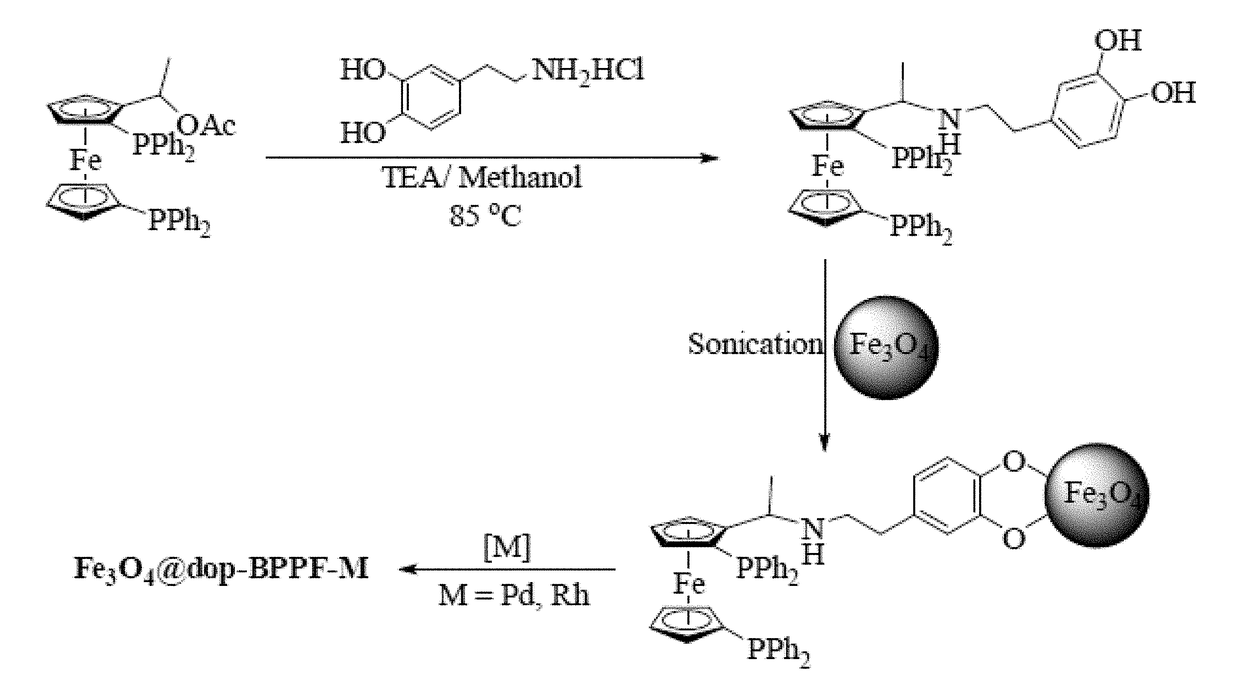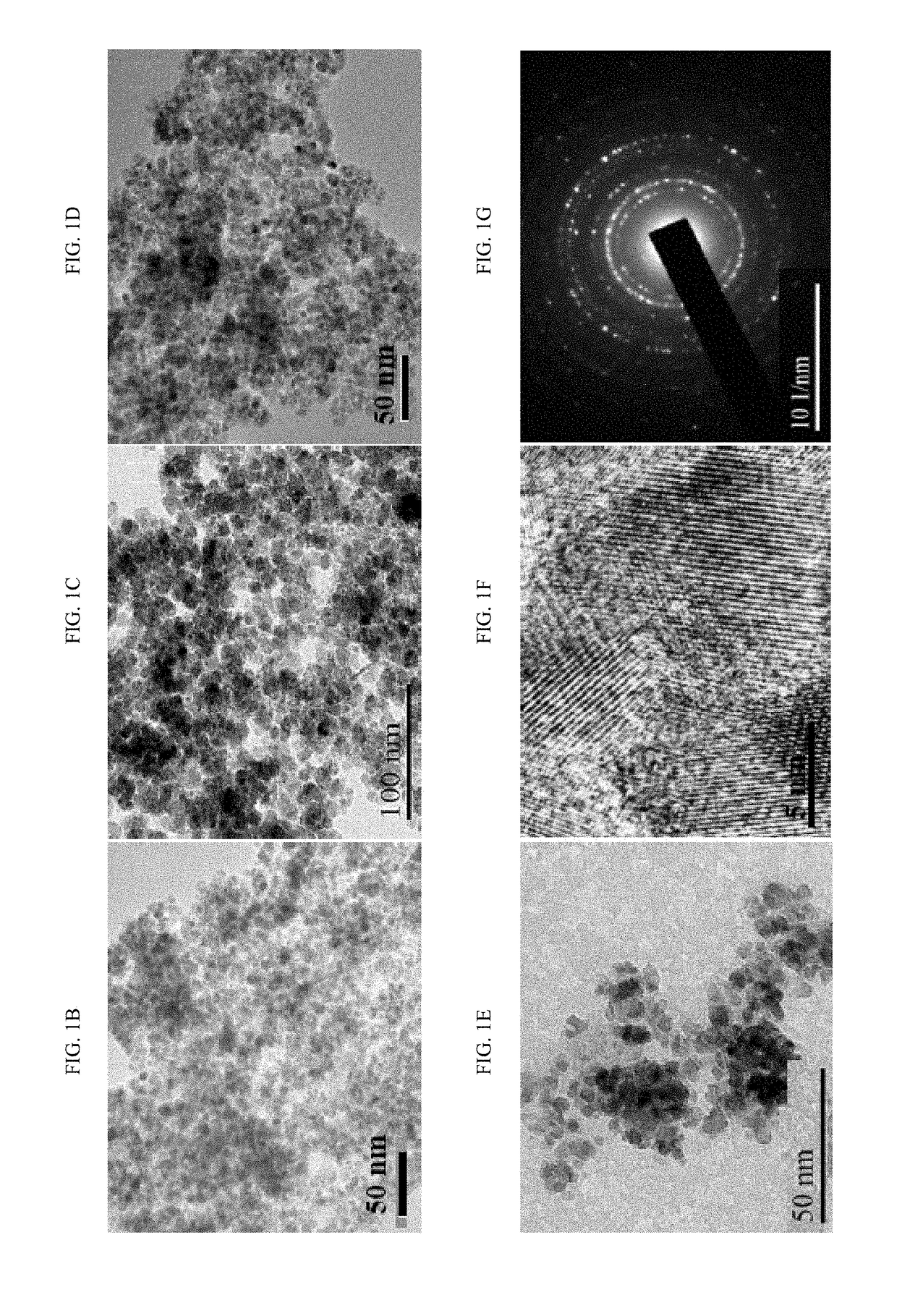Functionalized magnetic nanoparticle, a catalyst, a method for forming c-c bonds
a magnetic nanoparticle and catalyst technology, applied in the field of functionalized magnetic nanoparticles, catalysts, methods for forming cc bonds, can solve the problems of affecting the activity, reducing the scope of the process for cost-effective application, and reducing the efficiency of the catalyst,
- Summary
- Abstract
- Description
- Claims
- Application Information
AI Technical Summary
Benefits of technology
Problems solved by technology
Method used
Image
Examples
example 1
Experimental Materials and Methods
[0192]All of the chemicals were purchased from Sigma-Aldrich and used as received unless otherwise stated. An inert atmosphere and standard Schlenk techniques were used wherever needed. Standard procedures were followed for preparing dry and deoxygenated solvents. Deionized (DI) water was used throughout the experiments. The surface coating was carried out in a low-power bath sonicator (Cole-farmer model 08892-21). The 1H and 13C NMR spectra were recorded on a JEOL JNM-LA 500 spectrometer with tetramethylsilane (TMS) as the internal standard. The 31 P NMR spectra were recorded on the same spectrometer using a phosphorous probe and 85% H3PO4 as the internal reference. The FTIR spectra were obtained on a Nicolet 720 in the range of 400 to 4000 cm−1 using KBr pellet. The thermogravimetric analysis (TGA) data were obtained on a Mettler-Toledo model TGA1 STARe System at a heating rate of 10° C. / min in a temperature range of 25-600° C. in an argon atmosph...
example 2
Syntheses of the Compounds, Complex, Functionalized Magnetic Nanoparticle, and Catalyst
[0193]The syntheses of NN-dimethylferrocenyl ethyl amine (FA), N,N-dimethyl-1-[-1′,2-bis (diphenylphosphino)ferrocenyl] ethyl amine (BPPFA) and 1-[-1′,2-bis(diphenylphosphino)ferrocenyl]ethyl acetate (BPPFA-OAc) were performed according to previously reported procedures (G.-H. Hwang, E.-S. Ryu, D.-K. Park, S. C. Shim, C. S. Cho, T.-J. Kim, J. H. Jeong, M. Cheong, Organometallics 20 (2001) 5784-5787; and T. Hayashi, T. Mise, M. Fukushima, M. Kagotani, N. Nagashima, Y. Hamada, A. Matsumoto, S. Kawakami, M. Konishi, Bull. Chem. Soc. Japan 53 (1980) 1138-1151, each incorporated herein by reference in their entirety).
[0194]The synthesis involved the preparation of N,N-dimethyl-1-ferrocenylethylamine followed by dilithiation and reaction with chlorodiphenylphosphine to afford BPPFA (see FIG. 6) (T. Hayashi, K. Yamamoto, M. Kumada, Tetrahedron Lett. (1974) 4405-4408, incorporated herein by reference in i...
example 3
Characterization of the Synthesized Complex, Functionalized Magnetic Nanoparticle, and Catalyst
[0203]FIGS. 1B, 1C, 1D, and 1E are the transmission electron micrographs of Fe3O4, Fe3O4@dop-BPPF, Fe3O4@dop-BPPF-Pd, and Fe3O4@dop-BPPF-Rh, respectively. The micrographs show that the nanoparticles are spherically-shaped and uniformly distributed. The average diameter was 6-8 nm. The high-resolution transmission electron micrograph and selected area electron diffraction (SAED) image are shown in FIGS. 1F and 1G, respectively. The interplanar distance was determined to be consistent with the literature data (T. Rajh, L. X. Chen, K. Lukas, T. Liu, M. C. Thurnauer, D. M. Tiede, J. Phys. Chem, B 106 (2002) 10543-10552, incorporated herein by reference in its entirety). The SAED data also revealed higher order crystallinity, which was further confirmed by the X-ray diffraction (XRD) signature of the nanomaterial. The peaks located at 30.22°, 35.70°, 43.10°, 53.40°, 57.10° and 63.20° indicate t...
PUM
| Property | Measurement | Unit |
|---|---|---|
| diameter | aaaaa | aaaaa |
| temperature | aaaaa | aaaaa |
| pressure | aaaaa | aaaaa |
Abstract
Description
Claims
Application Information
 Login to View More
Login to View More - R&D
- Intellectual Property
- Life Sciences
- Materials
- Tech Scout
- Unparalleled Data Quality
- Higher Quality Content
- 60% Fewer Hallucinations
Browse by: Latest US Patents, China's latest patents, Technical Efficacy Thesaurus, Application Domain, Technology Topic, Popular Technical Reports.
© 2025 PatSnap. All rights reserved.Legal|Privacy policy|Modern Slavery Act Transparency Statement|Sitemap|About US| Contact US: help@patsnap.com



